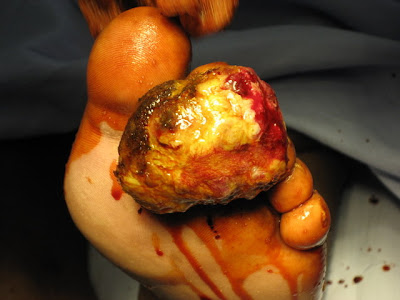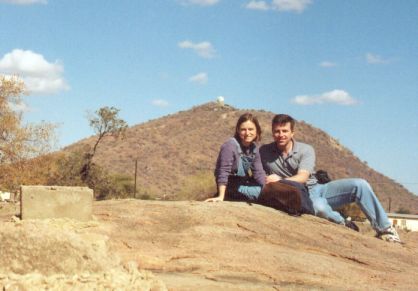Lucas is 27 years old and has HIV. He is still waiting to get placed on antiretroviral therapy in the regional government HIV center. He came to see me for a growing tumor on the base of his toe. Measuring 6cm across, I presumed this to be Kaposi’s sarcoma – a tumor much more common in people with HIV/AIDS. His toe was amputated and we have not seen a recurrence yet. Early diagnose and antiretroviral treatment would allow this tumor to be removed with simple cryotherapy (freezing it off).
Goiter
Marta is 45 years and her neck has been slowly swelling. She was starting to have trouble swallowing and breathing. She had a multinodular goiter – a benign growth of the thyroid usually caused by iodine deficiency in the diet. They are more common in highlands further from the ocean, as iodine is scarcer in such environments. Iodized salt has dramatically decreased the incidence of these tumors in developed countries. There is no iodized salt available where Marta lives. She required a major operation to get most of her thyroid removed. She now swallow wells, breathes well, and her voice is normal.

Sigmoid Teratoma
Leonora is 28 years old. She noticed something firm and round in the left lower quadrant of her abdomen. Physical exam and ultrasound findings both suggested a complex cyst of her ovary. We were quite surprised to find at her operation that her ovaries were normal. Instead, she had a complex tumor hanging off the side of her sigmoid colon. When I opened it, I found fatty tissue, glandular tissue, and bone. A teratoma (Greek for terrible tumor), benign in appearance, a tremendously rare presentation.
Pacemaker
Dona Iria is 67 years old and has lived for 2 years with an atrial bradycardia (slow heart rhythm) that keeps her heart rate between 35 and 40. She was often tired. A pacemaker is the only treatment. The nearest cardiologists are 800 miles north or south; bad roads or an expensive flight either way. All things considered, she was doing quite well – contentedly awaiting the arrival of volunteer Canadian cardiologists scheduled to arrive January 4. Christmas morning she fell ill, and showed up at the door of Dr. Steve Collins (see the previous blog entry), her neighbor. Her heart rate was even slower, she looked ashen. She was admitted to the hospital. Two days later, she had a seizure in front of me, stopped breathing, and her heart stopped. Amazingly, she recovered with CPR. A doctor conference and family conference immediately ensued. We presumed poor circulation to her brain led to the preceding cascade of events. The only treatment again was a pacemaker. She was too fragile to fly to Namibia to get one placed. Waiting another 10 days for the cardiologists to arrive seemed too long to wait. The remaining option was to place one ourselves (the device had already been donated by an American cardiologist). With Dona Iria’s and her family’s consent, we took her to the OR the following morning, with appropriate apprehension and prayerfulness. Steve had contacted the donating cardiologist for a few pointers over the phone. We placed the device, unfortunately without the usual x-ray guidance, having only a heart monitor to monitor her heart rhythm. She responded well enough, heart rate in the 60s, most of the time, and was discharged home. The visiting cardiologist did have to fine tune the placement in January, and now she is doing great.
As one can imagine, surgical care in Angola has been, on the whole tremendously gratifying. It seems that daily there are new challenges, new pathology, new fields to tackle. And many people do very well. All are extremely gracious, and even forgiving. While the above stories read as a list of victories, there have been many failures and many heartbreaking stories. Children and young adults lost to diseases like typhoid fever, abdominal tuberculosis. Some are lost to surgeon error. But many of our surgical deaths tie directly to lack of care that was standard 30 years ago at home. Lack of post-operative oxygen, inability to check and correct electrolyte and acid/base imbalances, and minimal nurse education has lead to a large number of our surgical complications.
Thank you for following us on our journey. Stay tuned. Next week: less gruesome pictures and reflections on public health from Beth!
 Me and Steve Foster after a long day in the OR.
Me and Steve Foster after a long day in the OR.



1 comment:
Yay, a Riviello Update! With tons of interesting pictures and stories too. I think that my hands may even have been featured in the picture with the ovarian tumour. Just that short visit pretty much convinced me to try pursue a direction in surgery. Some of those stories were quite uplifting (that pacemaker experience must have been quite incredible), and others simply seem to underscore the need in Angola for both better sustainable local medical/nursing education and 'modernization' of the medical testing and resources available there.
Post a Comment